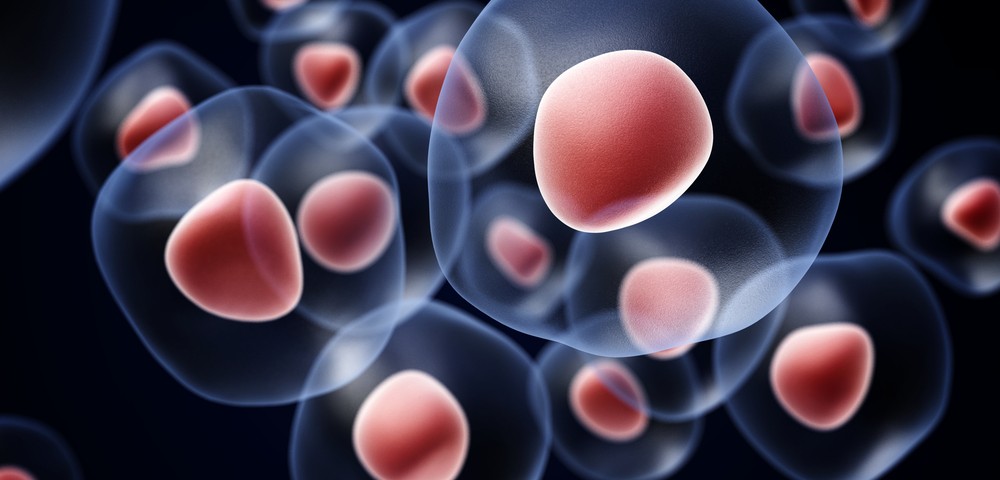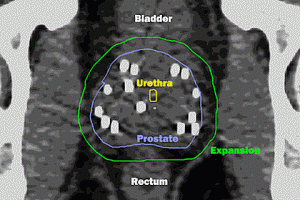Because the prostate gland is a tiny organ surrounded by other critical body structures, it is a challenge to deliver radiation treatments for prostate cancer without causing collateral damage to surrounding tissues. This damage can sometimes result in new problems such as erectile dysfunction and bladder or rectal irritation, with the hoped-for cure coming at a steep cost in diminished quality of life.
 “We always have to keep cure as our first priority, but quality of life is a major secondary concern for men with prostate cancer,” says Patrick W. McLaughlin, M.D., a professor of radiation oncology at the University of Michigan Medical School (UMMS) in Ann Arbor, Michigan.
“We always have to keep cure as our first priority, but quality of life is a major secondary concern for men with prostate cancer,” says Patrick W. McLaughlin, M.D., a professor of radiation oncology at the University of Michigan Medical School (UMMS) in Ann Arbor, Michigan.
 Happily, recent refinements in radiotherapy technology are making it increasingly possible to achieve a new standard of successful prostate cancer treatment cure and still maintain quality of life for the patient.
Happily, recent refinements in radiotherapy technology are making it increasingly possible to achieve a new standard of successful prostate cancer treatment cure and still maintain quality of life for the patient.
McLaughlin is senior author of a paper published in the journal Lancet Oncology that describes how MRI combined with a clear understanding of functional anatomy, and its variations among patients, can allow oncologists to plan treatments that spare critical non-target structures.
The Lancet paper, “Vessel-sparing radiation and functional anatomy-based preservation for erectile function after prostate radiotherapy,“ is co-authored by UMMS’s Jae Y. Lee, Daniel E. Spratt, Adam L. Liss, and Patrick W. McLaughlin, who observe that previous quality-of-life comparisons suggest an association of certain specific outcomes are made with particular types of prostate cancer treatment modalities (for example, surgery vs. radiation).
However, they report that a functional anatomy approach, starting with nerve-sparing prostatectomy, assumes that quality-of-life outcomes are established by anatomic preservation. They suggest that emerging applications of a functional anatomy approach to prostate radiation therapy will ultimately clear the way for development of individualized treatments that can address normal tissue variants visible on MRI. These techniques will encompass all essential functions affected by prostate radiation treatment, including genitourinary, rectal, and sexual functions.
In their review, the authors outline current techniques in functional anatomy-based preservation related to sexual outcomes, and also the capacity of vessel-sparing radiotherapy to preserve sexual function in 90 percent of patients at the five-year follow-up, while continuing to maintaining excellent rates of cure.
The team began their investigation by defining the critical body functions and structures that are located near or adjacent to the prostate, including nerves, vessels, and the sphincters that control bladder function, erectile function, and rectal function.
“The benefit of the functional anatomy approach goes well beyond improving sexual function. It has improved urinary and rectal function as well,” McLaughlin explains. “Both radiation oncologists and surgeons are conducting ongoing research to improve their understanding of the functional anatomy. This is critical for both disciplines as they work to eliminate cancer while preserving function.”
“We argue that current rates of side effects and changes after treatment are not fixed, and that further potential improvements in function preservation are possible and likely by pursuing this vessel-sparing approach,” said co-author Jae Lee, M.D., Ph.D., a radiation oncology resident at UMMS.
The investigators also determined that MRI is a critical tool for accurately outlining prostate anatomy and planning radiation therapy, noting that they could see the borders of the prostate on MRI easily and precisely as compared with images from CT, which they found to be much less clear, causing therapists to overestimate the area needing treatment. On the other hand, with a clear outline of the prostate and other critical structures provided by MRI, radiation oncologists can precisely target radiation treatment to the areas of the prostate where it’s needed, while avoiding critical erectile tissues — a technique called “vessel-sparing radiation.”
How It Works: Radiation doses are delivered by beams directed from many angles combined with implanted seeds (white spots). By integrating the two types of radiation, the highest dose is delivered only within the tumor. The external beams correct any irregularity from the seeds. Thanks to MRI planning, very little dose goes to adjacent structures. Image Credit – University of Michigan Medical School
The Lancet paper authors also observe that aggressive prostate cancer is often treated using a combination of implanted radiated “seeds” and external beam radiation — a course of therapy that has proved more effective than either method alone for treating aggressive cancers. They note that of 49 patients treated with therapy combining seeds and external beam radiation complimentarily, 92 percent reported maintaining the ability to be sexually active with at least five years of follow-up.
 “We found no difference in quality of life for men given aggressive treatment. If you define the functional structures and limit dose to them, you can achieve cure and excellent quality of life,” says co-author Daniel E. Spratt, M.D., chief of the genitourinary radiation oncology program at the University of Michigan.
“We found no difference in quality of life for men given aggressive treatment. If you define the functional structures and limit dose to them, you can achieve cure and excellent quality of life,” says co-author Daniel E. Spratt, M.D., chief of the genitourinary radiation oncology program at the University of Michigan.
A UMMS release notes that vessel-sparing radiation requires physicians to train in MRI anatomy analysis in order for them to be able to recognize and identify key structures. Co-investigator McLaughlin has previously developed a tool called Prostadoodle, available free online. Prostadoodle includes a section on defining the erectile vessels.
In addition, it is anticipated that MRI could provide helpful guidance for patients in deciding their best treatment option based on their unique anatomy and taking into account factors such as whether the tumor is outside the prostate gland, which would suggest need for radiation therapy after surgery. On the other hand, if surgery is chosen as primary treatment, does the patient have a short urinary sphincter? In that case, there is higher risk of incontinence after surgery.
“For patients who appear to have slow-growing, non-aggressive cancers, MRI can confirm there is no aggressive cancer present. For such patients, surveillance is an excellent choice,” McLaughlin said. “By avoiding treatment altogether when appropriate, all the side effects and quality of life impact from treatment is avoided.”
At the other end of the spectrum, MRI has the potential to reveal more serious cancers not identified by a biopsy which calls for shifting treatment to a more aggressive approach necessary to arrest and cure such cancers.
McLaughlin sees patients at the Assarian Cancer Center at Providence Park in Novi and Providence Cancer Center in Southfield, Michigan, which is part of the University of Michigan’s Radiation Oncology Network. All the research for the paper was completed at the UMMS Providence affiliate.


